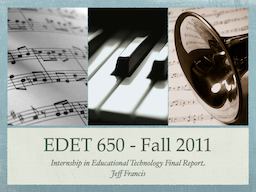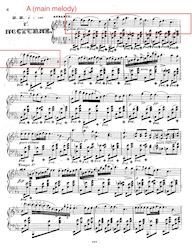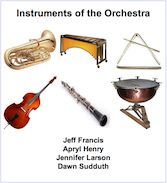-

Artifact: MUSC 100L Redesign & Multimedia Enhanced Listening Examples
Context: Completed in Fall 2011 as a part of EDET 650 Internship in Educational Technology. I assisted Dr. Julie Hubbert and Dr. Kunio Hara in the revision of a 1 credit course, MUSC 100L Recital Class Laboratory. This course is taken by all new music majors in their first semester. It is is being redesigned to foster the development of listening skills, critical thinking, and the ability to see music from an historical and cultural perspective. To this aim, the delivery is being changed to a blended delivery. My primary focus was developing enhanced musical listening examples which students will access online before meeting for instructor moderated discussion.

Conditions: While developing the enhanced musical listening examples I faced several challenges. Finding the right tool and workflow for building the examples was very important, especially as some of the musical pieces were changed very late in the internship. Copyright was also a major concern, as is discussed below.
Scope: The EDET 650 internship was during the first 4 months of a year-long course redesign. During that time we focused on the first portion of the course content - Western Classical Music - and I completed the enhanced musical examples for this section. The course redesign is still underway and is scheduled to be implemented in Fall 2012.
Role: Drs. Hubbert and Hara served as the course content designer and subject matter experts. I designed and developed the multimedia enhanced listening examples, built the course content wiki and implemented the streaming system to comply with copyright.
ADDIE: This project would have benefited from an explicit use of an instructional system design model. As it was, the course re-designers and I performed extensive analysis of the learners, their entry conditions and their needs, but we did not have explicit design and development stages. Because of this, many changes were made to the design along the way, including replacing some content in the last few days.
In retrospect, I probably should have overstepped my limited role (as an intern for only a fraction of the redesign time) to implement a more definitive ADDIE process.
Performance indicators:
2.0.1 Select, use and apply appropriate media using design principles to produce effective learning environments, instructional and professional products.
Through discussions with Drs. Hubbert and Hara, the course re-designers and subject-matter experts, we determined the need to revise the course to use the limited in-class time (50 minutes per week) for discussions that tapped higher cognitive levels. To this end, they were looking to move musical listening examples and basic analysis of these to something the students could prepare before the weekly course meeting. I conceived of the idea of a multimedia enhanced musical listening example, which combines the audio recording of a musical performance synchronized with the musical score and overlaid with commentary.
2.4.2 Develop and prepare instructional materials and products for various distance education delivery technologies
3.4.4 Identify and implement effective policies related to the utilization, application, and integration of instructional technologies.
3.4.5 Identify policies and regulations which apply to the utilization, application, and integration of distance delivery technologies.
The multimedia enhanced musical listening examples were designed for distance delivery. A dimension of 1024x768 was chosen, since musical scores are best viewed in portrait orientation. Also, this is the native screen resolution of the iPad, which makes an ideal viewing platform. The listening examples and the accompanying historical content will be delivered via BlackBoard once the new course comes online.
3.4.1 Identify and apply standards for the use of instructional technology.
3.4.2 Identify and apply policies which incorporate professional ethics within practice.
3.4.3 Identify and apply copyright and fair use guidelines within practice.
Since the multimedia enhanced musical listening examples incorporate both audio recordings and musical score, adherence to copyright was a primary concern. Only music that was in the public domain was used, but this only applied to the score, not the recordings. To be sure that we did not violate copyright for the recorded music used, I utilized music already licensed by the USC School of Music Library and hosted it on the school’s streaming server to limit access to students enrolled in the course.
5.1.1 Identify and apply problem analysis skills in educational technology contexts (e.g., conduct needs assessments, identify and define problems, identify constraints, identify resources, define learner characteristics, define goals and objectives in instructional systems design, media development and utilization, program management, and evaluation).
I encountered and solved numerous problems during the EDET 650 Internship. These included developing an efficient workflow, determining the optimal streaming method and settings, developing workarounds for limitations in Camtasia's markup tools, and most of all - determining which content fit the goals and which did not.
Top
-

Artifact: The Instruments of the Orchestra Bookbuilder Book
Context: As a part of EDET 722 Instructional Design and Assessment, I worked with three other students using CAST’s UDL Bookbuilder to create an online digital book that is accessible to diverse learners. It was designed for use at the 3rd grade level. The book serves as preparation to familiarize students with the many different instruments in an orchestra, possibly before a field trip to hear an orchestra in person.
Conditions: This was the first course I took in the program and the first group project. The group experience turned out to be remarkably smooth and rewarding.
Scope: The digital book is available on CAST’s website. The final report (PDF, 466kB, opens new window), which documents the stages of the ADDIE process, is available as a PDF.
Role: This was a group project based on an idea I proposed to our ‘client’. I acted as the subject-matter expert and handled the recording of all the audio excerpts. I also worked extensively on the book layout and editing.
ADDIE: As seen in the final report, the creation of the Bookbuilder Book followed the ADDIE process. Even though our learners were fictional, our analysis of them and their needs was not.
Performance indicators:
3.4.2 Identify and apply policies which incorporate professional ethics within practice.
1.1.2.b Create instructional plans (micro-level design) that address the needs of all learners, including appropriate accommodations for learners with special needs.
1.1.4.a Use instructional plans and materials which they have produced in contextualized instructional settings (e.g., practica, field experiences, training) that address the needs of all learners, including appropriate accommodations for learners with special needs.
This digital online book was designed with diverse learners and Universal Design for Learning in mind. Content is presented as text, with text to speech available at all times and visual form, with alternate text provided for learners with visual impairments. Integrated 'helper' characters offer additional material in both text and speech form. Student are able to see and hear each instrument in the orchestra.
3.4.3 Identify and apply copyright and fair use guidelines within practice.
All audio recordings were either made specifically for the project, or permission was received for their use in the digital book.
Top
-
Go to the Management Artifacts page.

This work is licensed under a Creative Commons Attribution-NonCommercial-NoDerivs 3.0 Unported License.